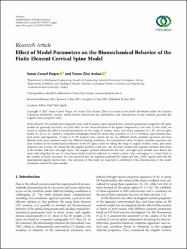| dc.contributor.author | Doğru, Suzan Cansel | |
| dc.contributor.author | Arslan, Yunus Ziya | |
| dc.date.accessioned | 2022-01-06T06:33:10Z | |
| dc.date.available | 2022-01-06T06:33:10Z | |
| dc.date.issued | 2021 | en_US |
| dc.identifier.citation | Doğru, S. C., & Arslan, Y. Z. (2021). Effect of Model Parameters on the Biomechanical Behavior of the Finite Element Cervical Spine Model. Applied Bionics and Biomechanics, 2021. | en_US |
| dc.identifier.issn | 1176-2322 | |
| dc.identifier.uri | 1754-2103 | |
| dc.identifier.uri | https://hdl.handle.net/20.500.12846/615 | |
| dc.description.abstract | Finite element (FE) models have frequently been used to analyze spine biomechanics. Material parameters assigned to FE spine models are generally uncertain, and their effect on the characterization of the spinal components is not clear. In this study, we aimed to analyze the effect of model parameters on the range of motion, stress, and strain responses of a FE cervical spine model. To do so, we created a computed tomography-based FE model that consisted of C2-C3 vertebrae, intervertebral disc, facet joints, and ligaments. A total of 32 FE analyses were carried out for two different elastic modulus equations and four different bone layer numbers under four different loading conditions. We evaluated the effects of elastic modulus equations and layer number on the biomechanical behavior of the FE spine model by taking the range of angular motion, stress, and strain responses into account. We found that the angular motions of the one- and two-layer models had a greater variation than those in the models with four and eight layers. The angular motions obtained for the four- and eight-layer models were almost the same, indicating that the use of a four-layer model would be sufficient to achieve a stress value converging to a certain level as the number of layers increases. We also observed that the equation proposed by Gupta and Dan (2004) agreed well with the experimental angular motion data. The outcomes of this study are expected to contribute to the determination of the model parameters used in FE spine models. | en_US |
| dc.language.iso | eng | en_US |
| dc.publisher | Hindawi Publishing Corporation | en_US |
| dc.relation.isversionof | 10.1155/2021/5593037 | en_US |
| dc.rights | info:eu-repo/semantics/openAccess | en_US |
| dc.subject | Lumbar Spine | en_US |
| dc.subject | Trabecular Bone | en_US |
| dc.subject | Modulus | en_US |
| dc.subject | Degeneration | en_US |
| dc.subject | Validation | en_US |
| dc.subject | Density | en_US |
| dc.subject | Omurga | en_US |
| dc.subject | Trabeküler Kemik | en_US |
| dc.subject | Dejenerasyon | en_US |
| dc.subject | Lendenwirbelsäule | en_US |
| dc.subject | Trabekelknochen | en_US |
| dc.subject | Degeneration | en_US |
| dc.subject | Validierung | en_US |
| dc.subject | Dichte | en_US |
| dc.title | Effect of model parameters on the biomechanical behavior of the finite Element cervical spine model | en_US |
| dc.type | article | en_US |
| dc.relation.journal | Applied Bionics and Biomechanics | en_US |
| dc.contributor.authorID | 0000-0002-1861-9368 | en_US |
| dc.relation.publicationcategory | Makale - Uluslararası Hakemli Dergi - Kurum Öğretim Elemanı | en_US |
| dc.contributor.department | TAÜ, Fen Bilimleri Enstitüsü, Robotlar ve Akıllı Sistemler Ana Bilim Dalı Koleksiyonu | en_US |
| dc.contributor.institutionauthor | Arslan, Yunus Ziya | |
| dc.identifier.wosquality | Q4 | en_US |
| dc.identifier.scopusquality | Q3 | en_US |
| dc.identifier.wos | WOS:000674451600001 | en_US |

















